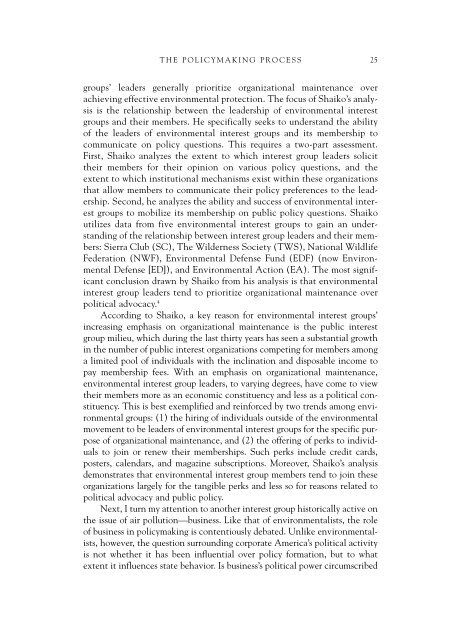GEORGE A. GONZALEZ - fieldi
GEORGE A. GONZALEZ - fieldi
GEORGE A. GONZALEZ - fieldi
Create successful ePaper yourself
Turn your PDF publications into a flip-book with our unique Google optimized e-Paper software.
THE POLICYMAKING PROCESS 25groups’ leaders generally prioritize organizational maintenance overachieving effective environmental protection. The focus of Shaiko’s analysisis the relationship between the leadership of environmental interestgroups and their members. He specifically seeks to understand the abilityof the leaders of environmental interest groups and its membership tocommunicate on policy questions. This requires a two-part assessment.First, Shaiko analyzes the extent to which interest group leaders solicittheir members for their opinion on various policy questions, and theextent to which institutional mechanisms exist within these organizationsthat allow members to communicate their policy preferences to the leadership.Second, he analyzes the ability and success of environmental interestgroups to mobilize its membership on public policy questions. Shaikoutilizes data from five environmental interest groups to gain an understandingof the relationship between interest group leaders and their members:Sierra Club (SC), The Wilderness Society (TWS), National WildlifeFederation (NWF), Environmental Defense Fund (EDF) (now EnvironmentalDefense [ED]), and Environmental Action (EA). The most significantconclusion drawn by Shaiko from his analysis is that environmentalinterest group leaders tend to prioritize organizational maintenance overpolitical advocacy. 4According to Shaiko, a key reason for environmental interest groups’increasing emphasis on organizational maintenance is the public interestgroup milieu, which during the last thirty years has seen a substantial growthin the number of public interest organizations competing for members amonga limited pool of individuals with the inclination and disposable income topay membership fees. With an emphasis on organizational maintenance,environmental interest group leaders, to varying degrees, have come to viewtheir members more as an economic constituency and less as a political constituency.This is best exemplified and reinforced by two trends among environmentalgroups: (1) the hiring of individuals outside of the environmentalmovement to be leaders of environmental interest groups for the specific purposeof organizational maintenance, and (2) the offering of perks to individualsto join or renew their memberships. Such perks include credit cards,posters, calendars, and magazine subscriptions. Moreover, Shaiko’s analysisdemonstrates that environmental interest group members tend to join theseorganizations largely for the tangible perks and less so for reasons related topolitical advocacy and public policy.Next, I turn my attention to another interest group historically active onthe issue of air pollution—business. Like that of environmentalists, the roleof business in policymaking is contentiously debated. Unlike environmentalists,however, the question surrounding corporate America’s political activityis not whether it has been influential over policy formation, but to whatextent it influences state behavior. Is business’s political power circumscribed









